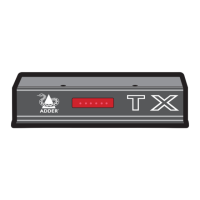sll
3
AIM basics
Channels
Think of a channel as a ‘virtual transmitter’. It is virtual because the video,
audio and USB streams of a channel do not necessarily have to originate
from the same physical transmitter unit, although in most cases they will. For
instance, you could arrange for video and USB streams to be received from
one host computer, while the audio stream came from an alternative source.
Alternatively, two channels could be configured for the same host computer,
each with different access rights to suit particular situations.
Groups
In order to accommodate potentially large numbers of users and devices, AIM
uses a system of groups: User Groups, Receiver Groups and Channel Groups.
Groups allow the administrator to apply collective settings to all members and
also to take full advantage of Inheritance. Inheritance allows members of a
group to benefit from settings and permissions made within other groups to
which their group is linked. This saves administration time because members do
not need to be individually altered. For instance, if Sam is in User Group 1, all
Channels accessible to User Group 1 will be available to Sam.
User types
This guide refers to the two main categories of users involved with the AIM
system:
• AnAdmin (administrator) user accesses the AIM system via a network-
linked computer running an Internet browser. Once the necessary username
and password have been entered, Admin users can make changes to the
operation of the AIM system.
• ARegular user has a keyboard, video monitor and mouse (plus speakers
where appropriate) attached to an AdderLink Infinity receiver unit and
can access one or more computers that are linked to AdderLink Infinity
transmitters. The AdderLink Infinity receiver provides an On-Screen Display
(OSD) that lists all accessible computers and allows easy access to them.
User
AIM
Receiver Channel
Access
denied by
default
Access
permitted
by default
Access always permitted
Security
Security considerations form a major part of AIM operation, ensuring that users
have rapid access only to the systems for which they have permission. At its
core, AIM manages an important three-way relationship between the users, the
AdderLink Infinity receiver(s) and the channels from the host computers.
The diagram shows a representation of the three-way relationship which exists
between users, receivers and channels.
To successfully gain access to a channel:
• The user requires permission to use the receiver,
• The receiver requires permission to connect with the channel,
AND
• The user must have permission to access the channel.
In most cases, the need for three access permissions per connection is
unnecessary and raises administration overheads. Hence, by default, AIM grants
open access for the user to the receiver and the receiver to the channel while
restricting the final, most crucial piece of the puzzle. For those who require it,
the lock upon the user to receiver stage can be applied individually or globally.
See Permissions on the next page for more details.
continued

